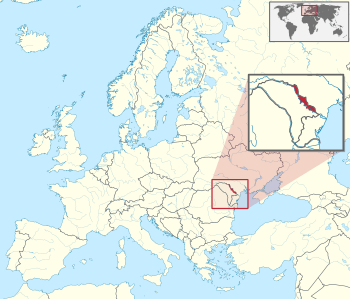Transnistria facts for kids
Quick facts for kids
Pridnestrovian Moldavian Republic
|
|
|---|---|
|
|
|
|
Anthem:
Мы славим тебя, Приднестровье (Russian) My slavim tebja, Pridnestrovje (transliteration) We sing the praises of Transnistria |
|
 |
|
| Status | Unrecognised state Recognised by the United Nations as de jure part of Moldova |
| Capital and largest city
|
Tiraspol |
| Official languages | |
| Inter-ethnic language |
Russian |
| Ethnic groups
(2015 census)
|
|
| Demonym(s) | Transnistrian, Pridnestrovian |
| Government | Unitary semi-presidential republic |
|
• President
|
Vadim Krasnoselsky |
| Aleksandr Martynov | |
|
• Speaker of the Supreme Council
|
Alexander Shcherba |
| Legislature | Supreme Council |
| Partially recognised state | |
|
• Independence from SSR of Moldova declared
|
2 September 1990 |
|
• Independence from Soviet Union declared
|
25 August 1991 |
|
• Succeeds the Pridnestrovian Moldavian Soviet Socialist Republic
|
5 November 1991 |
|
• Transnistria War
|
2 March – 21 July 1992 |
|
• Recognition
|
3 non-UN membersc |
| Area | |
|
• Total
|
4,163 km2 (1,607 sq mi) |
|
• Water (%)
|
2.35 |
| Population | |
|
• 2018 estimate
|
469,000 |
|
• Density
|
114/km2 (295.3/sq mi) |
| GDP (nominal) | 2007 estimate |
|
• Total
|
US$1.0 billion |
|
• Per capita
|
US$2,000 |
| Currency | Transnistrian rubled (PRB) |
| Time zone | UTC+2 (EET) |
|
• Summer (DST)
|
UTC+3 (EEST) |
| Calling code | +373e |
| Internet TLD | nonef |
|
|
Transnistria, Transdniestria, or Pridnestrovie, officially the Pridnestrovian Moldavian Republic (PMR; Russian: Приднестровская Молдавская Республика, romanized: Pridnestrovskaya Moldavskaya Respublika), is a partially-recognized state in Eastern Europe.
During the Romanian occupation of 1941–44, between 150,000 and 250,000 Ukrainian and Romanian Jews were deported to Transnistria; the majority were executed or died from other causes in ghettos and concentration camps of the Governorate.
After the Red Army reconquered the area in 1944, Soviet authorities executed, exiled or imprisoned hundreds of the Moldavian SSR inhabitants in the following months on charges of collaboration with the "German-fascist occupiers". A later campaign was directed against the rich peasant families, who were deported to Kazakhstan and Siberia. Over the course of two days, 6–7 July 1949, a plan named "Operation South" saw the deportation of over 11,342 families by order of the Moldovian Minister of State Security, Iosif Mordovets.
The country is recognized by three other partially or unrecognized states, Abkhazia, Nargorno-Karabakh Republic, and South Ossetia. The country declared independence from Moldova on 2 September 1990. With the help of the Russian army, it defeated the Moldovan army in the War of Transnistria.
There has been peace since 1992, but the Council of Europe calls Transnistria a "frozen conflict" region.
There is argument about whether it is really a country or not. The region continues to boast independence, and acts independently over its territory with the help of peacekeeping forces from foreign countries.
In a vote in 17 September 2006, 97% voted to be free from Moldova. This vote has not been accepted by Moldova, which calls the territory the "Territory of the Left Bank of the Dniester".
Transnistria is the only independent state to still use the hammer and sickle on its flag.
Images for kids
-
Soviet symbols are used in Transnistria.
-
Igor Smirnov with Vladimir Voronin and Dmitry Medvedev in Barvikha, 18 March 2009
-
Dniester River in Bender
-
The Transnistrian parliament building in Tiraspol, fronted by a statue of Vladimir Lenin
-
Tiraspol City Council
-
Tiraspol, capital of Transnistria
See also
 In Spanish: Transnistria para niños
In Spanish: Transnistria para niños





















